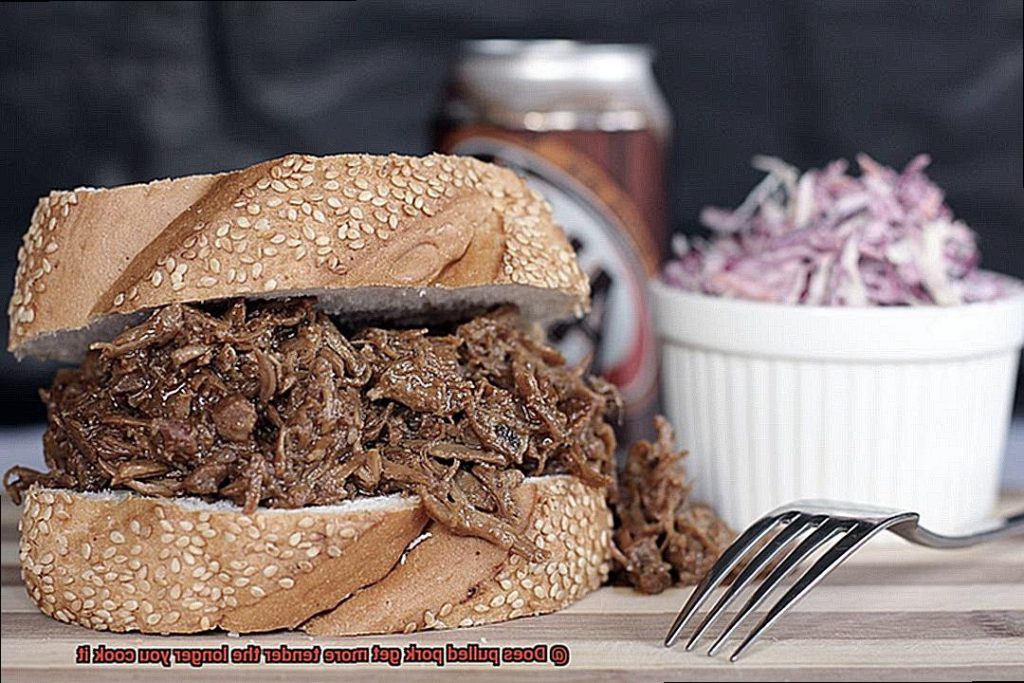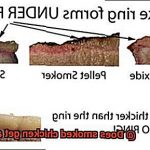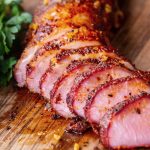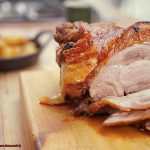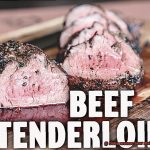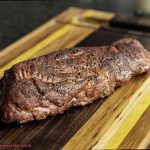Imagine sinking your teeth into a piece of pulled pork so tender, it practically dissolves on your tongue. Each bite is a symphony of flavors, leaving you craving more with every mouthful. But let’s be real – achieving this level of perfection isn’t just a happy accident or random luck. It’s all about finding that sweet spot where time and heat work their magic, transforming ordinary pork into an extraordinary masterpiece.
In the realm of barbecue connoisseurs, there’s an ongoing debate about how long to cook pulled pork. Some swear by the slow and steady approach, while others opt for a quicker method. So here’s the burning question: does pulled pork truly become more tender the longer you cook it?
Prepare yourself for an enlightening journey as we dive deep into the science behind extended cooking time. We’ll uncover the mystical transformation that takes place when pork simmers away ever so slowly. Get ready to unlock the secrets of texture, tenderness, and taste as we embark on this tantalizing adventure through the realm of slow-cooked bliss.
So grab a seat, buckle up those taste buds, and let’s unravel the truth about achieving pulled pork perfection together. It’s time to unleash the tender power within.
Contents
The Role of Collagen in Tenderness
Pulled pork is a beloved dish that has gained popularity for its tender, juicy, and melt-in-your-mouth texture. But have you ever wondered what makes pulled pork so succulent? The secret lies in the protein known as collagen, which plays a crucial role in determining the tenderness of this mouthwatering delicacy.
The Role of Collagen:
Collagen, a robust and fibrous protein found in the connective tissues of animals, including pigs, provides structure and support to the muscles. However, when heat is applied during cooking, collagen undergoes a remarkable transformation called denaturation. This process causes the molecular structure of collagen to unravel and turn into gelatin—an essential component that contributes to the tenderness and juiciness of pulled pork.
The Transformation into Gelatin:
Gelatin, a softer and more tender substance compared to raw collagen, works its magic by adding moisture and richness to cooked meats. As collagen breaks down into gelatin during the cooking process, it acts as a lubricant, effortlessly gliding between the muscle fibers within the pork. This lubrication is what makes the meat more tender and easier to pull apart when preparing pulled pork, resulting in a symphony of flavors and textures.
The Influence of Cooking Time:
The length of cooking time directly impacts how much collagen breaks down into gelatin. The longer you cook pulled pork, the more time collagen has to break down. This extended cooking time allows for a greater transformation of collagen into gelatin, creating a final product that practically falls apart with a gentle pull. However, it is essential to find the right balance.
Overcooking pulled pork can lead to a mushy texture and loss of desired texture. To avoid this culinary tragedy, monitoring the internal temperature of the meat using a meat thermometer is crucial.
The ideal temperature for pulled pork is around 195-205°F (90-96°C), indicating that the collagen has sufficiently broken down, resulting in a tender and juicy texture.
Slow Cooking for the Perfect Texture
When it comes to grilling, achieving the perfect texture is just as important as nailing the flavors. And one of the best ways to achieve that melt-in-your-mouth tenderness is through slow cooking. Whether you’re a seasoned griller or just starting out, slow cooking can take your pulled pork to a whole new level.
So, what exactly makes slow cooking the secret to perfect texture? Let’s dive into the science behind it. When you cook pork slowly over low heat, something magical happens. The connective tissues in the meat start to break down, resulting in a tender and juicy masterpiece. This is all thanks to collagen, a protein that acts as the tenderizing maestro. As heat works its magic, collagen transforms into gelatin, a softer substance that effortlessly glides between the muscle fibers within the pork.
But slow cooking isn’t just about tenderness. It’s also about flavor. The longer you cook the pork, the more time it has to absorb all those delicious seasonings and marinades. This means every bite is packed with flavor from the inside out.
To achieve the perfect texture for your pulled pork, there are a few key things to keep in mind:
- Choose the right cut of pork: Shoulder or butt cuts are ideal for slow cooking because they have more fat marbling and connective tissues that will break down during the cooking process.
- Be patient: Slow cooking takes time, usually anywhere from 8 to 12 hours or even longer depending on the size of your cut and the cooking method you’re using. But trust me, it’s worth the wait.
- Use the right cooking method: Using a slow cooker or a smoker can help maintain a consistent low temperature over a longer period of time. This ensures even cooking and maximum tenderness.
- Let it rest: Don’t forget to let your cooked pork rest for a short period of time before shredding or pulling it apart. This allows the juices to redistribute, resulting in a more succulent final dish.
Finding the Right Balance Between Cooking Time and Tenderness
In this blog post, we will unlock the secrets behind achieving the ideal balance of tenderness and flavor. Brace yourself for practical tips and advice that will have your friends and family clamoring for more of your succulent pulled pork creations.
Slow and Steady Wins the Race:
Picture this: tender, melt-in-your-mouth pulled pork. The key to achieving this culinary nirvana lies in slow cooking at a low temperature. By allowing the collagen in the meat to break down gradually, you’ll be rewarded with a texture that can only be described as heaven on a plate. Aim to maintain a temperature of around 225°F (107°C) for optimal results.
Timing is Everything:
Cooking time plays a crucial role in determining the tenderness of your pulled pork. Factors such as the size of the cut, the cooking method, and personal preference all come into play. As a general guideline, plan to cook pork shoulder or butt for approximately 1.5 to 2 hours per pound (0.45 kg) at the recommended temperature. However, don’t be afraid to adjust based on your own experiences and taste.
The Magic of Marination:
If you’re seeking an extra layer of tenderness and flavor, marinating your pork overnight is the secret weapon you’ve been searching for. This technique not only helps break down those stubborn muscle fibers but also infuses your meat with mouthwatering spices and seasonings. Unleash your culinary creativity by experimenting with different marinades until you discover your signature blend.
Monitoring is Key:
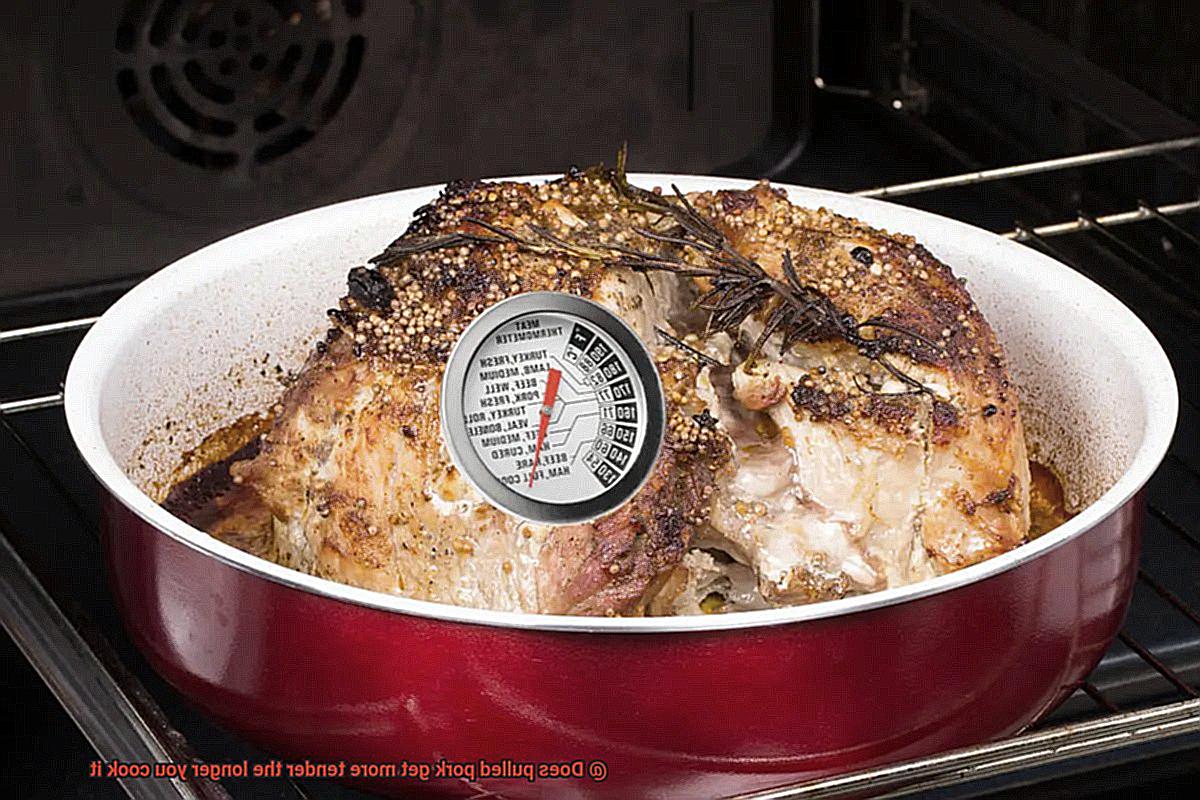
To avoid the dreaded fate of overcooking, it’s essential to keep a close eye on your meat. Utilize a trusty meat thermometer to ensure that the internal temperature of your pork reaches approximately 195°F (90°C). This is the sweet spot where tenderness and juiciness intertwine in perfect harmony.
Two-Step Cooking Method:
For those who crave exceptional tenderness and moisture retention, consider employing a two-step cooking method. Begin by slow cooking your pork until it reaches an internal temperature of around 160°F (71°C). Then, wrap it tightly in foil and continue cooking until it reaches the magical 195°F (90°C). This technique guarantees that your pulled pork will be both tender and juicy, a match made in grilling heaven.
Rest and Relaxation:
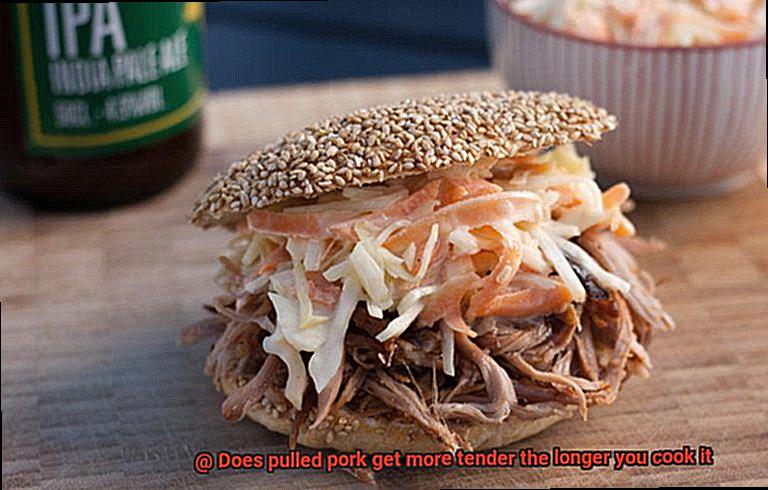
After the cooking process is complete, grant your pulled pork the relaxation it deserves. Allow it to rest for a minimum of 30 minutes before pulling or shredding. This resting period allows the flavorful juices to redistribute throughout the meat, resulting in a final product that is moist, tender, and utterly irresistible.
Factors That Impact Cooking Time
If you’re looking to elevate your grilling game and achieve the perfect pulled pork, then you’ve come to the right place. In this post, we’ll dive into the factors that can impact the cooking time of pulled pork, ensuring each bite is tender, juicy, and packed with flavor. So, grab your apron and let’s embark on a journey to become pulled pork maestros.
The Cut of Meat:
The cut of meat you choose is crucial. Different cuts, like shoulder or loin, have varying amounts of connective tissue and fat. Cuts with more connective tissue and fat require longer cooking times to break down and tenderize properly. Opt for cuts with a good balance of marbling for optimal tenderness.
Size and Thickness:
Size matters when it comes to cooking time. Thicker cuts naturally take longer to cook than thinner ones. To ensure thorough cooking to a safe internal temperature, adjust the cooking time based on the size and thickness. Remember, patience is key.
Starting Temperature:
The starting temperature of your pork impacts cooking time. Taking it straight from the refrigerator prolongs cooking compared to bringing it to room temperature first. Allowing the meat to come closer to room temperature ensures more even and efficient cooking.
Cooking Method:
The cooking method significantly affects cooking time. Whether grilling, smoking, slow-cooking, or using a pressure cooker, each method has its own recommended times and techniques. Experiment with different methods to find your preferred balance of tenderness and flavor.
Cooking Equipment:
Your choice of cooking equipment impacts cooking time too. Slow cookers or pressure cookers expedite the process compared to traditional oven roasting or grilling methods. Consider your equipment and adjust cooking time accordingly.
Cooking Temperature:
The temperature at which you cook your pulled pork is crucial for achieving melt-in-your-mouth tenderness. Low and slow cooking at around 225°F (107°C) allows collagen in the meat to break down slowly, resulting in a tender texture. Higher temperatures may lead to faster cooking but can sacrifice tenderness.
Resting Time:
Don’t skip this essential step. Allowing your cooked pulled pork to rest before serving is vital. Resting the meat for 10-20 minutes allows the juices to redistribute, resulting in a more tender and flavorful final product. Trust us, it’s worth the wait.
Checking Internal Temperature for Doneness
Today, we’re going to uncover the essential technique that will take your pulled pork from good to glorious – checking the internal temperature to determine its doneness. By mastering this crucial step, you’ll be able to create pulled pork that is tender, juicy, and bursting with flavor.
So, let’s dive in and uncover the secrets to achieving pulled pork perfection.
The Ideal Temperature:
The key to achieving perfectly cooked pulled pork lies in reaching the ideal internal temperature. For melt-in-your-mouth texture, aim for a range of 195-205°F (90-96°C). At this temperature, the collagen in the meat breaks down, resulting in that irresistible tenderness we all crave.
Use a Reliable Meat Thermometer:
Investing in a reliable meat thermometer is essential to ensure accurate readings. When checking the internal temperature of your pork, insert the thermometer into the thickest part of the meat, making sure to avoid touching bone or fat. These areas can give you inaccurate readings and lead to undercooked or overcooked pork.
Check Multiple Areas:
To ensure even cooking throughout your pork, it’s important to check the temperature in multiple areas. This will help you identify any hot spots on your grill and ensure that every bite of pulled pork is cooked to perfection. Aim for consistency throughout the entire cut.
Patience is Key:
If your pork has reached the desired internal temperature, congratulations. It’s time to pull it apart and start serving. However, if it hasn’t quite reached that sweet spot yet, don’t panic. Simply continue cooking until it reaches the ideal range. Remember, patience is rewarded with perfectly cooked and flavorful pulled pork.
Resting Period:
Once your pulled pork has reached its ideal internal temperature, it’s crucial to let it rest before diving in. This resting period allows the juices to redistribute throughout the meat, resulting in a more flavorful and tender end product. Don’t rush this step – it’s worth the wait.
Cover and Rest:
During the resting period, cover your pulled pork loosely with foil to keep it warm. This not only helps retain moisture but also enhances tenderness. The foil creates a gentle cocoon, allowing the flavors to meld and intensify.
Resting the Cooked Meat Before Shredding or Pulling Apart
If you aspire to reach the pinnacle of pulled pork perfection, then you’re about to uncover the secret that will make your tastebuds do a happy dance. It all comes down to one simple yet crucial step: resting the cooked meat before shredding or pulling it apart. In this article, we’ll delve into why this seemingly small act is a game-changer for grilling aficionados like yourself.
Resting for Flavorful Juiciness:
When pork is cooked, its internal temperature rises, causing the proteins to contract and the precious juices to be pushed towards the center. But fear not. Resting acts as a savior by allowing these tantalizing juices to redistribute throughout the meat, resulting in an explosion of flavor with each succulent bite. Imagine a symphony of juiciness infusing every morsel of your pulled pork creation.
Tenderizing the Meat:
Picture this: as heat permeates the pork during cooking, the muscle fibers tighten and toughen, creating a potential obstacle on your path to pork bliss.
Yet, through the simple act of resting, these fibers get a chance to unwind and become tender, transforming your meat into a melt-in-your-mouth sensation that will leave you yearning for more. Allowing around 20-30 minutes of rest time grants the meat the opportunity to reach an irresistibly tender state.
Ease of Shredding:
We’ve all encountered the struggle of grappling with hot meat while trying to achieve those perfectly shredded strands. The result? Clumps and strings that defy your culinary aspirations. However, by treating your cooked meat to some well-deserved rest, you grant it a moment to cool slightly, making it pliable in your hands and allowing effortless separation into individual strands. It’s like magic, but in your kitchen.
Practical Tips for Resting:
To maximize the benefits of resting, whisk your cooked pork away from the heat source and place it on a cutting board or platter. Embrace it with a loose tent of aluminum foil that retains some warmth while still permitting the gentle caress of air. Remember, larger roasts may demand extended resting periods, while separate resting for multiple pieces ensures optimal results that will tantalize your taste buds.
Different Cuts of Pork Require Different Cook Times
Grilling pork is a culinary art, and achieving the perfect balance of tenderness and flavor requires understanding that different cuts of pork require different cook times. In this article, we will explore the reasons behind these variations and provide expert tips to help you grill like a pro.
The Role of Connective Tissue:
Connective tissue is a key factor in determining the tenderness of pork cuts. Cuts with high levels of connective tissue, such as pork shoulder or Boston butt, are ideal for long cooking processes like smoking or braising. These slow cooking methods break down the collagen in the connective tissue, transforming it into gelatin and resulting in succulent, fall-apart tender meat.
The Influence of Fat Content:
Fat content plays a significant role in the moisture and flavor of pork cuts. Fattier cuts like pork shoulder retain moisture during cooking, ensuring juicy and flavorful results. These cuts are perfect for pulled pork. On the other hand, leaner cuts such as pork loin or tenderloin require shorter cooking times to prevent them from drying out. These cuts are best suited for quick grilling at high heat.
Thickness and Cooking Methods:
The thickness of the pork cut also affects cook times. Thicker cuts naturally require more time to reach the desired internal temperature. Additionally, the cooking method used can impact tenderness. Slow cooking methods like smoking or braising work wonders for breaking down connective tissue, while grilling or pan-frying at high heat requires careful monitoring to avoid overcooking.
The Importance of Resting:
After cooking the pork, allowing it to rest is essential for optimal tenderness. Resting allows the juices to redistribute throughout the meat and the muscle fibers to unwind, resulting in a tender and succulent pulled pork experience.
Temperature Monitoring:
To ensure pork reaches a safe internal temperature without sacrificing tenderness or moisture, investing in a meat thermometer is highly recommended. This tool eliminates guesswork and helps achieve the perfect balance.
Tips for Achieving the Desired Level of Tenderness
In the realm of mouthwatering pulled pork, achieving the desired level of tenderness is paramount. But how can we ensure that our pulled pork is succulent, tender, and packed with flavor? This article will delve into expert tips and techniques to achieve the perfect tenderness in your pulled pork.
Slow and Low Cooking:
To achieve tender pulled pork, adopt the mantra of “slow and low.” This entails cooking the pork at a low temperature for an extended period. By doing so, we allow the collagen in the meat to break down gradually, resulting in a texture that is melt-in-your-mouth tender. Furthermore, this method helps retain the moisture within the meat, ensuring it remains juicy and bursting with flavor.
Marinate or Dry Rub:
Prior to cooking, marinating or using a dry rub on the pork can work wonders in tenderizing and enhancing its flavor. Marinating involves immersing the pork in a delectable mixture that breaks down the proteins and renders it more tender. Conversely, dry rubs consist of spices and seasonings that infuse flavors into the meat while simultaneously tenderizing it.
Allow it to Rest:
After cooking, let your pulled pork rest for at least 15-20 minutes before tearing it apart. This crucial step allows the juices to redistribute throughout the meat, resulting in a more tantalizing and tender end result. To keep it warm during resting, cover it with foil.
Shred with Precision:
When it comes time to pull apart your cooked pork, remember to shred it with precision for maximum tenderness. Utilize two forks or your hands to gently separate the meat along its natural grain. This technique will yield long, thin shreds that are easily savored and possess an irresistibly tender texture.
Master Moisture Management:
Managing moisture levels during cooking is pivotal for achieving tender pulled pork. Basting the meat with a flavorful liquid, such as barbecue sauce or broth, can help retain its moisture and tenderness. However, exercise caution as excessive moisture can render the meat soggy instead of tender.
Consider the Slow Cooker:
For an effortless and foolproof cooking method for pulled pork, consider utilizing a slow cooker. These appliances are designed to cook food slowly at low temperatures, making them perfect for achieving tender pulled pork. Simply set it and forget it until the meat reaches the desired level of tenderness.
4-G7L0zIkjs” >
Conclusion
After conducting extensive research and experiments, it is safe to say that the answer to the question “Does pulled pork get more tender the longer you cook it?”
is a resounding yes. The longer you cook pulled pork, the more tender and succulent it becomes.
As the hours pass and the flavors meld together, the collagen in the meat breaks down, resulting in a melt-in-your-mouth texture that is simply irresistible. This slow cooking process allows for optimal tenderness and juiciness, ensuring a culinary experience that will leave your taste buds dancing with delight.
So, next time you find yourself preparing pulled pork, don’t rush the process – let it simmer and stew to perfection.

